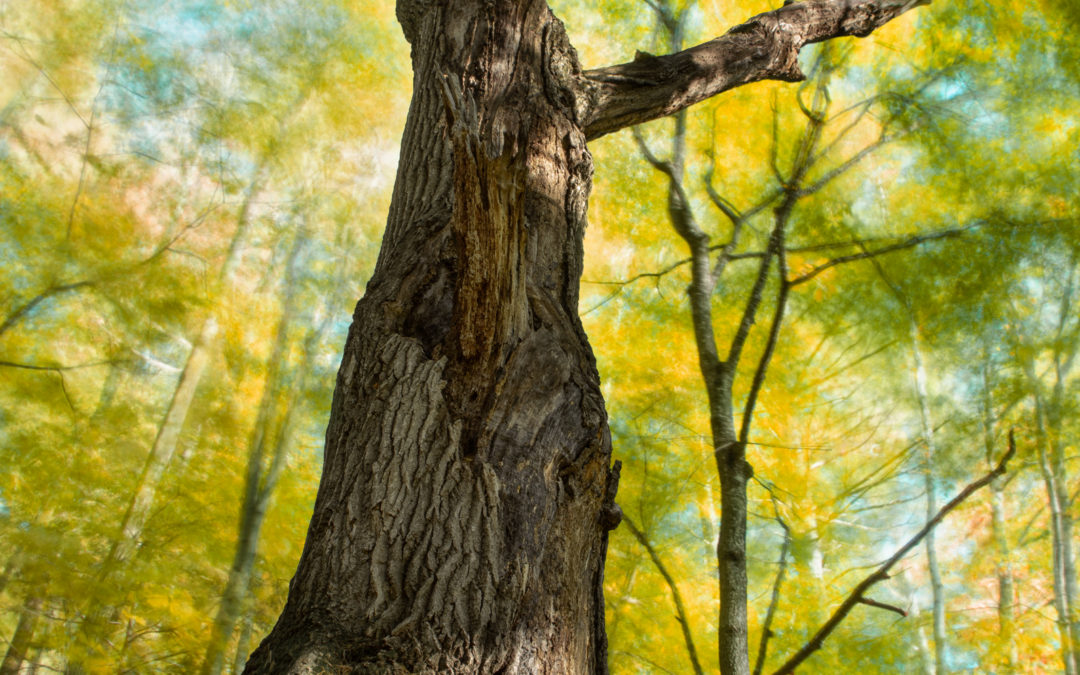This massive red oak, Quercus rubra, is in view of a major road in New Hampshire and stands about 200 feet from a trailhead, yet I suspect almost no one has really ever seen it, and very few have ventured to its base. It is on a very steep hillside, and once the foliage is out, it is almost invisible—even though it is about six feet in diameter at breast height (DBH) and closer to ten feet if measured as it swells out at ground level. For perspective, I could quite easily crawl into that cavity at its base.
I only saw this tree in passing, one day last fall when most of the leaves were off the trees (I must have walked by it a dozen times). Looking up from the trail while foraging for mushrooms, I thought to myself, “That’s a pretty big red oak.” But only when I scrambled up to it, did I realize just how massive it was.
Now this old tree has seen a lot, clearly, and is pretty beat up. Only about a third of its crown is still alive, and great sheets of bark hang in tatters. It has rotten holes shot all through it, is cracked and shattered in places, and a bear could hibernate in its rotted base. Yet here it is, and it will likely be around for a very long time.
I’ve taken several people to see this tree, which I have named “The Reaching Oak,” and each time the reaction is the same. After great buildup, I stop on the trail and ask if they can see the tree. They always say they can’t pick it out, even though it’s just a hundred feet away; and then I lead them carefully down to it (or up, depending on where we started from), and invariably they just get very quiet, and then their mouths hang open a bit. The scale is almost too much to take in. This is one impressive living thing.
The first day I saw The Reaching Oak, I knew I needed to photograph it. But, I wanted to take a picture that accomplished several things:
- To clearly show the almost anthropomorphic reaching of its largest branches, which, to me, convey a sense of the tree saying to the elements, “Come on, do your worst.”
- To capture its bulky stillness (you could drive a truck into this thing and I don’t think it would budge); I wanted an image that conveyed the fact that this tree has stood in this spot, unmoving and immovable, likely since before we were a a nation.
- And, to contrast #2, to show the dynamic forest around it, ever changing, and on the move. A forest that will one day usurp the oak as it inevitably fades into the duff.
To put all this together, I needed exactly the right conditions. I needed foliage, but not too much (or things would be too obscured), I needed enough light to capture the detail of the trunk (it’s some dark on this hillside), and, above all, to accomplish #3, I needed ferocious wind, to give motion to the surrounding forest. After months of waiting, the perfect conditions finally came together.
And so there you have it. Timelessness and the eroding march of time, stillness and movement, the new and the ancient, the old guard and the new, infancy and dottering old age, hope and demise, all together in one image. This is one of my favorite nature photos in recent years.
Here’s the much bigger Flickr image.
Meta: Pentax K-3, Pentax 15mm f/4 lens @f/14, ISO 100, shutter speeds between 1/30th and 30 seconds, 6-stop neutral density filter, gusts to 45, about a dozen images composited, plus many adjustment layers


